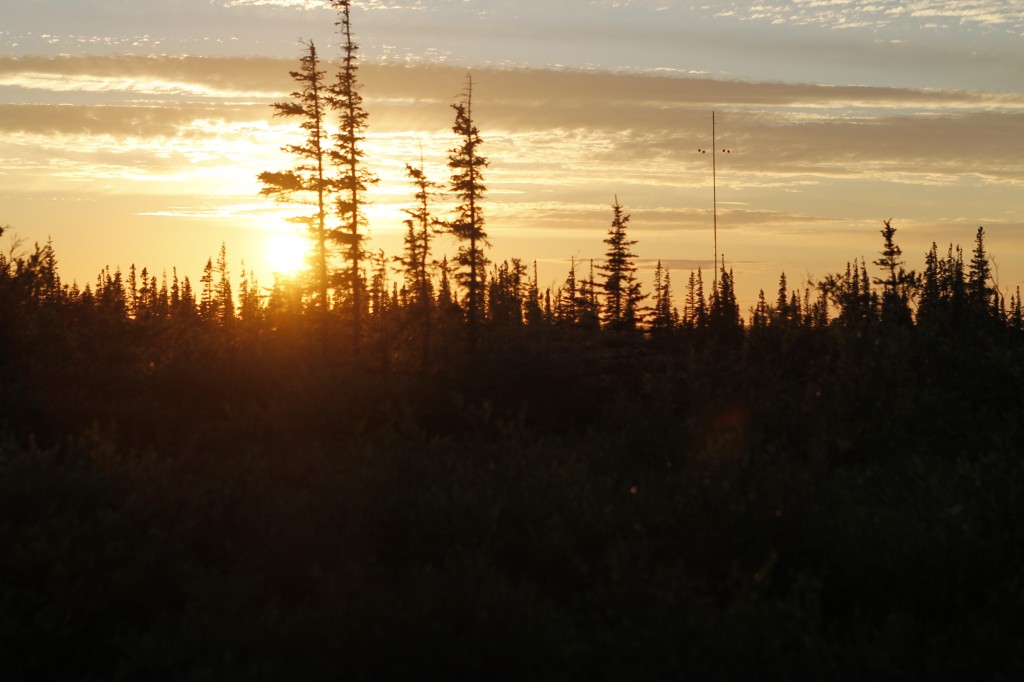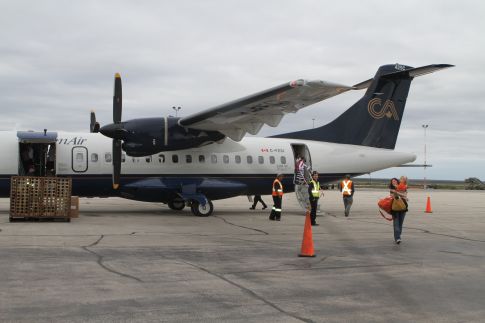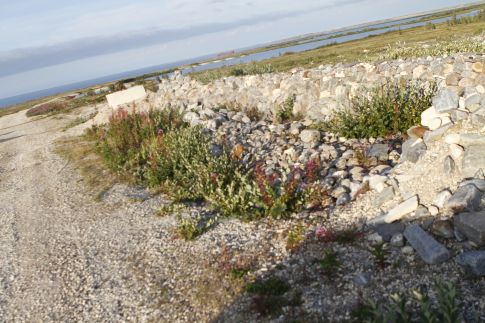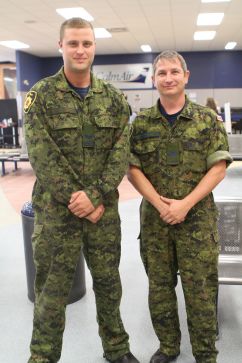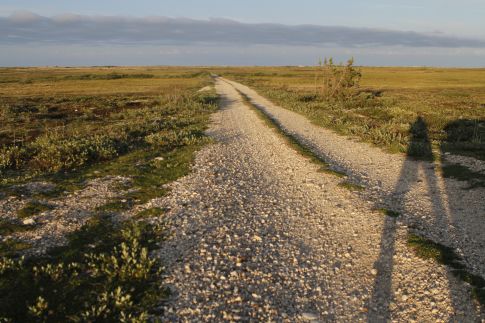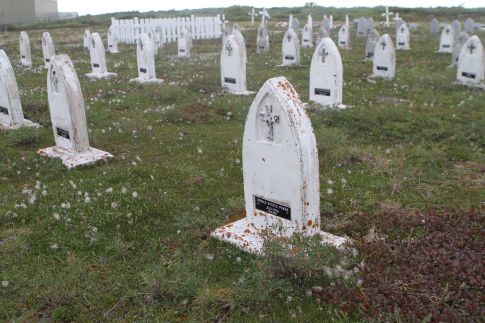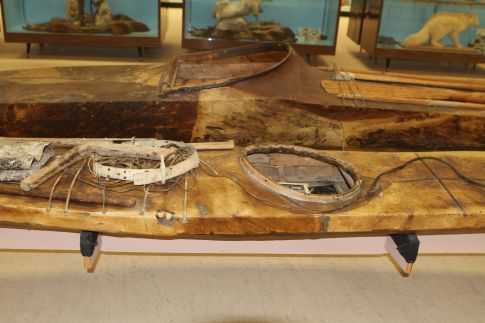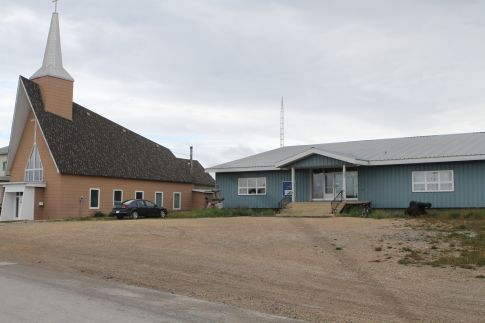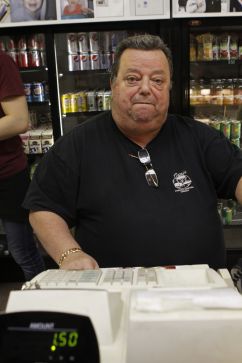I didn’t know what to expect from Churchill, a town in northern Manitoba that is renowned for polar bear spotting in October and November.
The small Canadian town of 900 people, which is in the polar bear migration path, feels more like a village than it does a town, but one that has the flavor of what you may see on the outskirts of an urban area, except rather than fast food chains being an integral part of the ugly monotonous sprawl, its a gas station, a couple of Arctic lodges and hotels instead.
How fitting that a 30 or so seater flight that heads to northern Canadian prairie towns should be on an airline called Calm Air. I was befuddled by the strict security out of Winnipeg.
After six passport checks and the over-the-top security guard who wouldn’t let me pass through the gate with a drop of water in my water bottle (and I mean a drop), I began to wonder whether I was flying from the Middle East to Washington DC rather than from a mid-sized Canadian city to a rural one, where the biggest security risk is potentially being attacked by a large white polar bear.
The flight attendants were equally strict, watching my every move and not leaving my sight until the buckle was fastened and my bag strap was no longer showing from below my seat.
It didn’t make it easy to go to the bathroom four times during the flight since I had to wolf down three bottles of water before hitting the airport security line.
Equally challenging was the fact that the bathroom door didn’t close and there was no water from the tap.
I was never more aware that I was heading to a remote place, not just one small in size, but one that was far from civilization and surrounded by harsh natural elements in the winter, and swarms of flies in the summer. The odd juxtaposition about the non-working bathroom on the flight filled with misfits (including myself) was the beautiful French that came over the intercom frequently with updated messages from the Captain.
As the plane began to drop, the first thing I noticed was the burnt sienna colored soil out the window. The wet sand was surrounded by water puddles and green and saffron colored grass and it was spread out across a very flat terraine. It wasn’t quite 5 pm and the sky was a grayish murky blue, layered with slivers of muted white cloud and peach undertones. Given the dullness of the white clouded sky, I had no idea that I still had more than 5 hours of daylight left.
I asked two young guys sitting behind me why they were heading to Churchill and they both said they didn’t know. Huh? They were heading up for work for an ‘excercise’ but didn’t know what they were going to work on. Dressed in civilian clothes, they met up with six Canadian men in the armed forces, who I later learned were firefighters on a ‘mission’ for five days.
In from Nova Scotia and Newfoundland.
The shuttle van for the Seaport Hotel where I was staying, had not arrived so I observed the chaos around me in Churchill’s tiny airport and outside area, which had a pick up area large enough for four cars and a parking lot, where you didn’t seem to have to pay to park there.
Lorraine finally pulled up saying that they didn’t have me on their ‘airport pick-up’ list and after I replied no problem, she talked non-stop until we reached the hotel, with a side detour along the Hudson Bay coast which was immediately behind their hotel.
A non-stop talker in a place like northern Canada typically means that they’re great storytellers and she was the first of many I’d meet over the next few days who was. The first thing I learned about was something she referred to as BEAR JAIL and as she said it, I realized it was something the town has had in place for so long, it didn’t seem odd to her that the name might just raise an eyelid or two. She pointed to it in the distance as we drove by the site, an area not far outside the airport exit.
When the bears get too close to the people in the town in late summer, they sedate the bears and toss them in a long tubular structure until the end of November when they sedate again and let them loose for their natural migration path at that time of year. They don’t feed them when they’re inside the “jail” except for snow on occasion since they don’t want the bears to associate food with humans.
Later, we would drive through Polar Bear Alley, where the grass was so high that even if you went ‘four wheeling’ and headed towards the sea, you couldn’t go ‘too too far’ because of “Explosive
Signs” on the property.
It’s a place that has so many odd juxtopositions that you don’t quite know where to start. Says Lauren, the 2o something your old in the car that picked me up who was working here for the season, “Churchill has a ‘lure’ to it.” Why do people move here I asked? (thinking it can’t be for the 50 below temperatures, the polar bear attacking risks or the cemeteries….) “MONEY,” she said loudly and without hesitation. “There’s no jobs further south and I get paid 2-3 times what I would in another area.”
Apparently nurses receive roughly a $12,000 bonus and others get what they refer to as “on call pay,” so the dollars add up despite the limited restrictions and social life.
I asked about social life, not just to the 20-something your old nurses I ran into who originally hailed from other parts of Canada. “We don’t swim,” they said….”we have icebergs here most of the year. In July, when it’s the hottest time of the year, we still don’t swim and you get out of your car, even then, with caution. You never know when a polar bear will be hanging around.” What else is there? I found myself asking as the car made its way through the town for hours on end, thinking at this point, I had seen everything that Churchill had to offer.
You see, I got lucky. While I was thinking about ‘how to explore’ the town without a car, a local woman who worked for the hospital stopped her car and offered me a lift. My memory (story) went a ‘bit like this:’
“The place felt desolate when I first landed. Hotel across the street from a hardware store. Skinny dogs who looked underfed for weeks and months, not days. Abandoned shopping carts, tractors and 20 horsepower boats along the side of the road. There weren’t pedestrians….except for me of course. Walking, walking, walking. The Canadian flag was glowing in the wind against a very muted white cloudy sky, giving off the kind of light that photographers hate, myself included. I make the best of nevertheless and attempt to shoot the skinny dogs, the abandoned shopping carts, the tractors and the boats.
Then I see the Arctic Trading Post which seemed to be as desolate as the rest of the town despite the fact that I had already bonded with several locals who were friends of the owners and said I couldn’t leave town without stopping by. And so, I didn’t. See my adventure here.
When the place is closed however, its energy which you can imagine adding life to the town otherwise, is equally quiet, desolate and deadening. I read the mustard-colored signs over and over again against Churchill’s eerie silence: Eskimo carvings, Furs Bought & Sold, Jewelry, Old Fashioned Candy, Indian Prints & Handicrafts, Army Surplus & Arctic Clothing, Dog Team Trips and Arctic Char.
At the far end of the town is a white sign that is plastered over an extension of a house. 2 doors, 3 windows, 1 sign: Northern Cuisine. I then see a sign that says “Anglican Church, Historical Site” but there’s no one to be seen in any direction. At the end of the road which turns into the even quieter and colder Hudson Bay, I start to lose myself. A pick up passes and I’m jolted out of my silence…for a moment. I hear the sound of birds, what sounds like winter birds and yet it’s late August. Oh yeah, I’m in Canadian’s Arctic I think as I notice the wind picking up around me.
I start to wonder what peak season is like knowing that I’m not there during OFF-SEASON, at least not entirely. The weather was warm enough, polar bear sightings are not unheard of at this time fo year and yet…..
Where were all the people I couldn’t help but wonder? I see a truck off in the distance….Tundra Buggy Tours. I knew I didn’t want to do that even if I was offered. Well, maybe. I wanted a local to drive me around, I was thinking. I spot a log cabin. It is closed. Nearby, there’s a statue of a teal and purple polar bear with fur trees painted on his back. The road swerves around but there still isn’t a sidewalk.
The rocks and vegetation along the side of the road ignite an interest in me to ask more questions…but to whom? No one is around. While there hasn’t been a car or person in quite awhile, another pick-up passes me as I think about the cool rocks I just saw. (I collect them and despite my short attention span, it’s amazing how long I can get lost in a mountain of rocks…..even people who collect stamps, ants and bugs may not quite understand this fascination).
It had been years since I had hitch-hiked and yet I was yearning to get picked up by some car or another. I had thought about it on more than one occasion over the course of an hour while I was meandering around and not because I was bored (although I was wondering where the F-K everyone was) and not because it wasn’t possible to get around another way. (renting a car would have been more work than you’d care to imagine however so hitching in hindsight seemed like a viable option although I had not planned it…or for it).
Then, a CAR stopped, while I was making a note, right after shooting another grayish rock with purple and green bleeding out, bland to others, yet intoxicating to someone like me who marvels in stones. All stones.
She had a passenger in the front seat (an Indian male) and a girl in her early twenties in the backseat. “Do you need help?” she asked. “Am just exploring the area,” I said. “I just arrived,” which was half true since I felt as if I had been exploring for days, not hours. Her name was Lorraine and she had so many stories to share, starting with Brian Ladoon’s Canadian Eskimo dogs.
Knowing I was taking a small plane across the Hudson Bay within the next 48 hours, I felt I didn’t NEED to see a polar bear before leaving the TOWN of Churchill.
While the town is only 900 in size today, it once housed 3,000 people when the Army had a base in Churchill. Since they moved out of Churchill, the population has dropped but it doesn’t mean that military activity doesn’t happen in Churchill on a regular basis. It is surrounded by a port, which means the Navy comes up for various exercises and in fact, was going to be there for my entire stay. The exercise? Performing a “mock disaster”over the next week, after which the Canadian Prime Minister was due to fly in for a visit. I later learned that Lorraine was married to the Mayor who was preparing for his visit. This was btw, the first of umpteen small-town incestuous references I was about to hear over the next several days.
The Navy opened up their friggits for an Open House on August 23, which allowed the local Churchill residents to visit so they could see what life was like on board. She pointed to a few off in the distance as we circled around the block so we could see the ocean in the distance while she entered the hotel parking lot from the rear. As we turned another corner, I asked about the large ugly brown monstrosity that faced the sea on one side and an apartment building on the other. Coined THE COMPLEX, it not only houses the town’s school (K through G12) but a curling rink, a skating rink, a swimming pool and a bowling alley.
After you finish walking to the port, have some tea at The Seaport Hotel and spend a couple of hours in the Eskimo Museum. (def worth visiting btw)
I ended up staying at the Seaport Hotel. The manager’s accent was so thick that I heard the Internet password incorrectly even after she repeated them three times. Now married to the mayor of the town, who owns the Seaport Hotel and dabbles in other things, she moved to Churchill to visit an old school friend 20 years ago and has made it her home ever since. When I asked her why she stayed, she said, “the pay down south wasn’t that good and at the time, I was making $1.90 an hour but could make $3.00 an hour in Churchill doing the same thing.”
Don’t expect luxury or state-of-the-art service at the Seaport Hotel. Keep remembering you’re there for the beluga whales and the polar bears. Before you leave however, you must stop into Gypsy’s, order a sandwich and soup and say hello to the Portuguese owner Antonio, who is quite a character.

Renee Blodgett is the founder of We Blog the World. The site combines the magic of an online culture and travel magazine with a global blog network and has contributors from every continent in the world. Having lived in 10 countries and explored nearly 80, she is an avid traveler, and a lover, observer and participant in cultural diversity.
She is also the CEO and founder of Magic Sauce Media, a new media services consultancy focused on viral marketing, social media, branding, events and PR. For over 20 years, she has helped companies from 12 countries get traction in the market. Known for her global and organic approach to product and corporate launches, Renee practices what she pitches and as an active user of social media, she helps clients navigate digital waters from around the world. Renee has been blogging for over 16 years and regularly writes on her personal blog Down the Avenue, Huffington Post, BlogHer, We Blog the World and other sites. She was ranked #12 Social Media Influencer by Forbes Magazine and is listed as a new media influencer and game changer on various sites and books on the new media revolution. In 2013, she was listed as the 6th most influential woman in social media by Forbes Magazine on a Top 20 List.
Her passion for art, storytelling and photography led to the launch of Magic Sauce Photography, which is a visual extension of her writing, the result of which has led to producing six photo books: Galapagos Islands, London, South Africa, Rome, Urbanization and Ecuador.
Renee is also the co-founder of Traveling Geeks, an initiative that brings entrepreneurs, thought leaders, bloggers, creators, curators and influencers to other countries to share and learn from peers, governments, corporations, and the general public in order to educate, share, evaluate, and promote innovative technologies.

